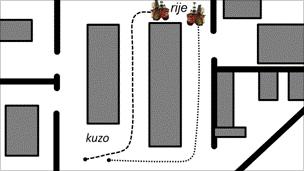Robots develop language to 'talk' to each other
- Published

Robots are developing their own language to help them navigate and improve their intellectual ability.
The Lingodroid research project lets robots generate random sounds for the places they visit in both simulations and a real office.
The "words" are shared and the robots play games to establish which sound represents which location.
The lexicon has proved so sophisticated that it can be used to help robots find places other robots direct them to.
The machines are being allowed to generate their own words because human language is so loaded with information that robots found it hard to understand, said project leader Dr Ruth Schulz from the University of Queensland.
"Robot-robot languages take the human out of the loop," she said. "This is important because the robots demonstrate that they understand the meaning of the words they invent independent of humans."
Robots engaging in a location language game. Video courtesy of the University of Queensland.
One set of the trials with Lingodroids sees wheeled robots fitted with a camera, laser-range finder, and sonar used to map their world - roaming around at an office at the University. The robots also have a microphone and speakers onboard so they can communicate with each other.
The wheeled robots travel about and, when they reach a place that does not have a name, they generate a random combination of syllables that represent that place.
When that robot meets another robot it tells it about the places it has been. Slowly, as the robots travel and talk, they narrow down their lexicon of place names until a mutual gazeteer of their world has been generated.
The robots generated place names such as "kuzo", "jaro" and "fexo".
Each location was broadly tied to the sensory horizon of the sonar and laser-range finder they have on board, said Dr Schulz. Each chunk of territory was typically a couple of metres in diameter, she said.
This enabled the names to be used as rough distance measures and allowed the robots to play other games which communicate distance, travel time and direction.
Some games involve swapping sounds but others, such as the "go-to-game" involve the robots trying to meet up at a distant location.
The power of the language being created by the Lingodroids was starting to become apparent, said Dr Schulz.
"They enable the robots to refer to places they haven't been or even places that they imagine beyond the edges of their explored world," she said.
Dr Schulz said work was continuing to enable the robots to generate and understand more place names and make their appreciation of their geography more subtle.
- Published19 May 2011
- Published17 February 2011
- Published17 November 2010
- Published25 October 2010